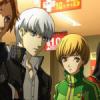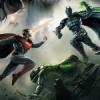Persona 4 Arena is a fighting game that favors speed and freneticism over carefulness. It rewards twitchy muscle memory over a chess-like game of footsies. It’s prone to jerky movements and craziness. It rewards people for mashing in many instances where they shouldn’t, but is often intimidatingly complex for people hoping to compete.
Being the first major release in the series to move away from the established RPG template, P4A isn’t exactly bad - despite having plenty of issues, it’s fun and memorable - but it’s not particularly great. There’s the trademark hidden depth to be found in the various interlocking systems that we’ve come to expect from Arc System Works, but it makes a number of mistakes that hold it back from being up there with the developer’s best work.
On the surface at least, a fighting game spin-off of a popular RPG series might come off as a blatant cash grab, playing on the popularity of the PS2 JRPG swan-song Persona 4. But it’s clear from the moment you start playing that a lot of thought and care has gone into ensuring that the presentation is top-notch. Character sprites are gorgeous and highly detailed with some fantastic animation, the music is infectiously catchy with many remakes of classic series tunes, and it’s clear that Arc System Works has worked hard to ensure that each fighter contains the same level of depth in their moveset that they’ve become known for.
This polish and depth comes at a price, however. Mechanically, P4A is fun, but by no means fair for beginners. Its tiers are relentless, and the game is cruel in matches where gulfs of skill exist. Astute understanding of technical mechanics will reward persistent players, whereas beginners may have difficulty. As a 2D anime fighter, the game is reminiscent of Blazblue: Continuum Shift and BlazBlue: ChronoPhantasma. However, the sheer speed by which its characters move compared to Arc System’s other games is noticeable. Characters zip from place to place, movement is much more liberal, and autocombos allow beginners to do damage.
One massive differentiation between P4A and many other fighting games is air turning. Air turning is where a character jumps over another character and turns to face the opponent. In P4A, air turning is manual until the character lands. This is a coup of a feature: because characters can press a button to air turn, this emphasizes the air-dash heavy nature of the game. Mixups, ambiguous cross ups, empty aerial jumps, and fuzzy guards are all complex maneuvers that are standard in high level play.
For a new player, this experience can be phenomenally daunting. P4A is a game where new players are sometimes unable to touch skilled foes at all. Characters such as Yu Narukami and Chie Satonaka have ground game setups (referred to in the community as Okizeme or “Oki”) that take advantage of their superior startups and recovery frames, allowing them to unleash a relentless assault. Characters like Mitsuru and Teddie can easily overwhelm opponents unfamiliar with their safe and unsafe block strings. And characters like Shadow Labrys and Yukiko can control spacing and unleash unblockables that can catch new (and sometimes veteran) players unaware.
P4A is very much a game aiming to be accessible to newcomers then, though after a gentle start they may soon find themselves feeling out of their depth. Each character has very specific strategies and playstyles so different from each other that it’s impossible to say one character plays like the other. What is important, however, is the marginal gain associated with mastering particular characters. Players who pick up Kanji versus players who pick up Narukami will find different gains in success. It’s not because of luck or mind games, but frame data. At it’s heart, it’s a relentless fighting game that, on higher levels of play, is remorseless in its need for perfection.
Yet regardless of its highly divergent tier list, P4A is quite good at rewarding effort and persistence. Because it works with such a small roster of characters, Atlus and Arc System Works was able to spend a considerable amount of time balancing characters, and it shows. Even the lowest tier characters such as Elizabeth and Kanji can stack up against higher tier characters like Narukami and Chie, given the player is intelligent and careful. It rewards boldness and cleverness, but never mindlessness. Even on higher-tier matches where okizeme games and set play is standard, a player with good understanding of his opponent’s abilities can severely limit their offensive power.
In short, there’s this peculiar dichotomy that P4A adopts: it’s either a beginner-friendly game with its burst mechanics and auto combos, or a highly tactical, space-heavy, twitch-fest. With both hands on your shoulders, it screams at you to mash buttons to win, but at the same time admonishes you when you lose due to adopting those tactics. So many of its vaunted and noticeable mechanics are situational and oftentimes unsafe, so it’s a weird, bumbling transition to fighting games.
But it is a transition to fighting games, and despite stumbling over some hurdles that’s where P4A stands out compared to the BlazBlues, the Street Fighters, the Guilty Gears, and the Marvel vs Capcoms of the fighting game community. It wasn’t built for people who already came in with knowledge of fighting games. It’s for the JRPG fans, drawn to Persona as a franchise, in love and interested by this quirky transition to a fighting game. It’s fan service, in other words.
As soon as you’re caught in its Venus Flytrap of a setup, there’s a strong indoctrination process that occurs. It gives you the tools you need to succeed in a fighting game, but you quickly find out they fail. Most of its innovations and unique qualities are substandard and mediocre, forcing you to find better and better strategies for success. And once you’re there, once you’ve gotten your hands on a strategy that works, you’re caught. You’re now a fighting game fan, looking up frame data, complaining about hitboxes and bitching about spacing, pokes, and gatlings. Soon enough you find yourself prowling Dustloop. After that you’re joining tournaments and riding a shitty Greyhound to Las Vegas for EVO.
With Arc System Works handling the gameplay mechanics, Atlus has contributed to the game’s story and script, with mixed results. P4A, like Persona 4, is exceedingly good at taking patently moronic or whacky premises and playing them with seriousness. While the idea of a robot schoolgirl wearing a tie with gun barrels for arms sounds ludicrous, it sort of works. While a secret covert ops team of college students led by a woman in a catsuit sounds ludicrous, it sort of works. The premise of a big bad creating a faux fighting tournament to entice its victims to fight on a mythical otherworld that could only accessible by TV sounds ludicrous, but it sort of works. It’s all very anime.
As with Persona 4 before it, P4A embraces that with tenacity and gumption. It oozes color and bubbly enthusiasm from every orifice. Stages are drenched in bright yellows and reds, glaringly gaudy, campy, and ostentatious, and it’s fine with that. It’s a game built upon competent writing - an area usually overlooked in fighting games - supporting a nonsensical premise.
While its multiple actors across multiple viewpoints premise is somewhat lengthy, bloated, and pretentious, at important points it can hit with surprising heft. Yu Narukami’s story is a standard hero fantasy tale, Kanji’s is water well tread, and Elizabeth’s is far weighed down with foreshadowing to be substantive, but Labrys’ story hits with girth and earnestness.
But although Labrys’ story stands out as a small, heartfelt, honest tale that encapsulates P4A’s core drama, it’s only a small part of an otherwise mediocre whole. Most of the stories are either bland or short, and most of them are either drenched in exposition or far too referential of the JRPGs to really have any meaning by themselves. Many of them talk about Yu Narukami coming back from Golden Week, and while there’s some drama when they enter the TV, it’s a standard friendship and fantasy tale. It’s populated by lengthy, explanation-heavy stories that are unafraid to bore you with walls of text and end before they ever really feel as though they’ve been given a chance to develop.
As a fighting game designed to be accessible to newcomers, P4A is often overly complex, uncaring, and gaudy. As a continuation of the Persona story, it’s more bone than meat - as sweet and tender as that meat sometimes is. But as a tool of conversion, P4A is surprisingly effective. It’s a gateway drug to the minutiae of the fighting game community, with both hands on gilded gates. As you enter those doors, you’ll hear the sounds of “Fuck da knicks” and “Scoops Haagen Daz.” And no matter how hard you try to claw back to the safety of turn-based JRPGs, you know that the only thing you can do is move forward. It’s over, it’s done.
This often frustrating and overwhelming transitional piece has made you a fighting game fan.






